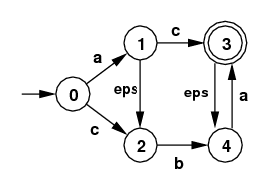|
CS 3721 Programming Languages Fall 2013 | |
Recitation 2. REs & ε-moves
| ||
Week 2: Sep 4 - 6
| ||
|
Note: Dates below changed on 10 Sep 2013
(2 and 3 days later). Submit following directions at: submissions and rules at: rules. Deadlines are:
|
1. Regular Expressions Read the page Regular Expressions. You need to understand the three operators used in regular expressions: their meaning, use, and precedence. You will see a number of examples.
- Give a regular expression that describes any string made of as, bs, and cs, with either at least one a somewhere or at least 2 bs somewhere. (You should only use the notation in the link above, and not other fancy notation. For example, no + operator.)
- Consider the FA below. Is it an NFA or a DFA?
Give a regular expression representing this FA. (Be careful to notice
which states are final states.)

2. ε-moves: ε-closure algorithm Read the page NFAs with ε-moves. You need to understand the ε-closure algorithm. Consider the NFA in Example 1 of the page RE −−> NFA that describes how to translate any regular expression into an NFA that accepts the same language. In this case the regular expressions is /.*(ab|aac)/, but here we're only interested in the first two steps of the subset algorithm applied by hand to this NFA, as part of the process of converting this NFA into a DFA, by hand. Later we'll talk much more about the whole process.

- Notice that the start state of the NFA is 2. The start state for the corresponding DFA won't be {2}, but will be ε-closure({2}). You are to apply the ε-closure algorithm to {2} step-by-step, showing at each stage states pushed on the stack and showing states as they are colored black. (The collection of all black states is the ε-closure.)
- Next, assume that the first input character is an "a". You are to calculate the result of following an arrow labeled with "a" or with "." to another state and making a set of these states. [Answer: {1,5,9}.]
- Finally, calculate ε-closure({1,5,9}) and show the calculation step-by-step as in the first item above.
3. ε-moves: Subset Algorithm Read the page NFAs with ε-moves. You should understand how the subset algorithm is extended to NFAs with ε-moves.
- Use the extended subset algorithm to find the DFA that
corresponds to the following NFA:

-
Suppose you want to handle the regular expression:
/ab(ab)*/.
The figure below gives this converted to an
NFA with ε-moves.
(Here "@" is what I use for ε in programs
(ε = the empty string).
This isn't the only NFA that will work, but this is the one
you must work with. Below, the transition from state
7 to state 10 should be labeled with @.)

- Carry out the extended subset algorithm on this NFA to get a DFA that accepts the same language. [Your answer should have 6 states including the empty set as an error state.]
- This DFA is not optimal: it doesn't have the minimal number of states. But it can be converted to that optimal DFA by identifying two of its states. Say which two need to be identified.
Revision date: 2013-09-05. (Please use ISO 8601, the International Standard.)
